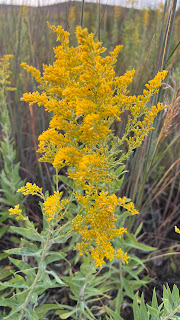"Dear Christmas Cacti, ProfessorRoush is not in the habit of complaining about flowers, but you have jumped the gun, premature in your pretentiousness, too fast in your florescence. I understand that Walmart may have out their Christmas merchandise in full display, but it is not even Hallow's Eve and yet here you are." Of course, I should remember that these epiphytic and lithophytic plants are native to Brazil, at coastal half-mile altitudes, where they are known as
Flor de Maio (May flower), and their flowering is triggered by the onset of cooler air and dwindling sunlight.
Imagine my surprise yesterday to see that most of our Christmas cactuses (cacti seems so abrupt as a plural) were blooming, some in full display, others just starting, and half still dormant, but all contributing to a sudden explosion of color in the sunroom. I hadn't been watching closely and they snuck the buds in without my noticing.
Schlumbergera in the sunroom seems like poor environmental placement, but these are behind opaque blinds that shield them from the summer Kansas sun.
I neglect these for the most part, watering every other week or every week as I remember them, turning the pots occasionally so they grow symmetrically. They are one of those plants that respond, evidently, to inattention, because most of these specimens are pot-bound and always on the verge of a little too dry. Oh, if every other living thing was so easy to care for! I can only feed the heck out of these and hope they bloom in cycles as they did last year, colorful from Thanksgiving to Easter, before they peter out and rest for the summer.
I've been, as you know, collecting colors as rapidly as the breeders frantically develop them, and although the classically-marketed Zygocactus was bright red (for CHRISTMAS), their palette range over the past few years has been greatly expanded. I used to have a red and white striped one as well, but I don't know if it's just currently reluctant to bloom or if I lost it in the great house freeze of 2004 (or whenever it was).
.jpg)
I like the new colors, truth be told, as much as the old classic red or white. I feel the vivid fuchsia at the top is just to die for, and the orange of paragraph #4 is one of the most unusual. The salmon to the right is a subtle hue, and the soft yellow variety below is much more rich-colored in person. Notice that I've long lost the variety names, if they ever existed, and merely describe them as the welcome color they are for the dreary months of winter. Here in the sunroom, I can look out windows at the dreary dying garden beyond and my eyes carry this color outdoors into the landscape.
One wonderful part of gardening and blogging is that I'm always learning something and today I've learned that the
Schlumbergera are divided into two main groups, the earlier-blooming Truncata, with pointed teeth, horizontal stems and flowers and yellow pollen, and the later-blooming Buckleyi, with more rounded teeth, flowers that hang down, and pink pollen. I appear to have primarily Truncata, since the pollen of all currently-blooming seems to be yellow and the flowers are all hanging down, and leaf shapes on the 7 plants not yet blooming seem similar to those that are. I'll have to search for the Buckleyi, now knowing there is a difference.





.jpg)
.jpg)
.jpg)









.jpg)
.jpg)
.jpg)
.jpg)
.jpg)
.jpg)
.jpg)
.jpg)
.jpg)
.jpg)
.jpg)
.jpg)
.JPG)
.jpg)
.jpg)
.jpg)
.jpg)
.jpg)
.jpg)



.jpg)

.jpg)
.jpg)

.jpg)
.jpg)
.jpg)
.jpg)
.jpg)
.jpg)
.jpg)
.jpg)
.jpg)
.jpg)
.jpg)
.jpg)
.jpg)